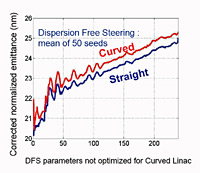Director's Corner
10 August 2006
 Barry Barish |
More Reflections on VLCW06: The ILC Reference Design
Last week I discussed the physics and detector part of the joint American Linear Collider Planning Group (ALCPG) and GDE workshop (VLCW06) held in Vancouver from 19-23 July. The GDE portion of the meeting focused on preparations for the Reference Design Report and had very large participation -- about 200 scientists and engineers. Participants reported on important progress on the accelerator design, as well as success in obtaining a first-cut at the costing of most components for the baseline machine.
 A new study reported at Vancouver indicates that it may be possible to contain emittance growth in an earth's curvature following main linac, which is our baseline configuration. |
The accelerator presentations at VLCW06 included an important recent study by Mauro Pivi and Lanfa Wang, both from SLAC. They suggest that by using clearing electrodes, electron cloud effects could be suppressed in the damping rings. This might allow the use of a single 6-km positron damping ring, rather than the present baseline which employs a pair of 6-km rings. The baseline uses two positron damping rings with the beam alternating between them, allowing enough separation between bunches to minimise the electron cloud effect. The new studies reported at VLCW06 are preliminary, but the damping ring group is already considering to submit a configuration change proposal. I'd like to emphasise that such a change would both simplify our configuration and significantly reduce costs.
Another interesting and important presentation involved emittance preservation in the main linac. This problem is easiest to handle in a laser straight linac, but we adopted a baseline that follows the earth's curvature. The advantages for helium distribution, cryogenic systems and civil engineering was the reasoning behind this recommendation. New studies by K. Ranjan, F. Ostiguy, N. Solyak, K. Kubo, P. Tenenbaum, P. Eliasson, A. Latina and D. Schulte show that it is possible to make beam designs that minimise emittance growth in the main linac by injecting a dispersive beam that compensates for the dispersion and vertical orbit in the linac. This encouraging result could be critical to our achieving the very small spot sizes at the interaction regions.
Our number-one goal at Vancouver was to obtain a first complete set of costing data, and we succeeded. The complete costing information will only be made available to the three cost engineers and myself. We must maintain confidentiality to protect proprietary information and to allow us to do our internal trade-offs and optimisations before we release costs in our Reference Design Report. Our next step in this process will be to validate component costs, to investigate areas where costs appear high, and to selectively look at potential design changes that might significantly reduce costs. We intend to vigorously pursue this program over the coming months, with the ultimate goals of coming forward with a reference design that has been optimised for cost to performance.
-- Barry Barish